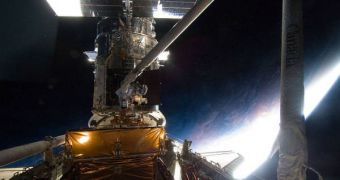After the resounding success of the STS-125 service mission to Hubble, scientists and engineers are currently working on bringing all the renewed or replaced instruments online, and also on calibrating them. This is a very important step in the observation procedure, as any tiny error that might occur could significantly alter the results astronomers get from the renewed observatory. When the calibration and test procedures end, somewhere around the end of this summer, the Hubble Space Telescope will again be opened up for scientific quests, aimed at peering as far back in the Universe as possible.
The new Wide Field Camera 3 (WFC3) and Cosmic Origins Spectrograph instruments aboard the venerable space telescope would run as smoothly as planned, mission controllers hope. The devices replaced the WFPC2, and the Corrective Optics Space Telescope Axial Replacement (COSTAR) instruments, respectively. The previous gadgets were nonoperational, or gave faulty readings. The new additions are expected to boost Hubble's sensitivity considerably for future explorations.
The Space Telescope Imaging Spectrograph (STIS) was also repaired, during the fourth spacewalk to fix the renowned observatory. The instrument made a series of groundbreaking discoveries, including the first spectrum of the atmosphere of an exoplanet, HD 209458b. It broke down in 2004, and could not be used since then. Hubble's main “eye,” the Advanced Camera for Surveys (ACS), was also repaired during the third spacewalk, when John Grunsfeld and Andrew Feustel removed four faulty electronics boxes from the instrument, and replaced them with new ones.
The telescope will also be able to report and maintain its position better, with the addition of three brand new gyroscopes, which replaced the older, damaged ones. The Fine Guidance Sensor (FGS) #3 was also replaced. The device is an interferometric instrument aboard Hubble that provides high-precision pointing information as input to the observatory's attitude control systems. This means that the craft will now be able to more accurately focus its instruments on a given point in space.
“Today begins the second Hubble revolution. Now we have increased Hubble's capability literally by orders of magnitude. Everything has passed its aliveness test and its functional test,” Space quotes Hubble's Senior Project Scientist Dave Leckrone as saying yesterday. The expert works from the Goddard Space Flight Center, in Greenbelt, Maryland, which oversees the operations of the telescope. “It's show time for us now. We got everything we asked for, we're going to have a great mission for years to come,” NASA's Hubble Program Scientist Eric Smith added.

 14 DAY TRIAL //
14 DAY TRIAL //